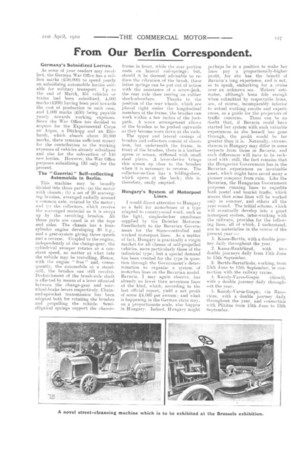From Our Berlin Correspondent.
Page 3

If you've noticed an error in this article please click here to report it so we can fix it.
Germany's Subsidized Lorries.
As some of your readers may recollect, the German War Office has a million marks (t30,000) to spend yearly on subsidizing automobile lorries suitable for military transport. Up to the end of March, 351 vehicles or trains had been subsidized, 4,000 marks (I:200) having been paid towards the (list of production in each case, and 1,000 marks (L50) being payable yearly towards working expenses. Since the War Office has decided to acquire for the Experimental Corps an Argus, a Diirkopp and an Ehrhardt, which absorb about 50,000 marks, there remains suffieient money for the contribution to the working expenses of vehicles already subsidized and also for the subvention of 10 new lorries. However, the War Office purposes subsidizing 133 only for the present.
The " Guerrini " Self-collecting Automobile in Berlin.
This machine may be broadly
into three parts: (a) the motor with chassis; (b) a set of 20 scavenging brushes, arranged radially around a common axle, rotated by the motor; and (0 the collectors, which receive the scavenged material as it is swept up by the revolving brushes. All three parts are cased in at the tops and sides. The chassis has a fourcylinder engine developing 30 h.p., and a gear-system giving three speeds and a reverse. Coupled to the engine, independently of the change-gear, the cylindrical sweeper rotates at a constant speed, no matter at, what rate the vehicle may be travelling. Hence, with the engine " free " and, valisequently, the automobile at a standstill, the brushes can still revolve. Declutehment of the brush-axle shaft is effected by means of a lever situated between the change-gear and rearwheel-brake levers respectively. Chainand-sprocket transmission has been adopted both for rotating the brushes and propelling the vehicle. Semielliptical springs support the chassis
frame in front, while die rear portiou rests on lateral coil-springs ; but, should it be deemed advisable to re. duce the vibration of the brush, these latter springs can be put out of action with the assistance of a screw-jack, the rear axle then resting on rubber shock-absorbers. Thanks to the position of the rear wheels, which are placed right under the longitudinal members of the frame, the brushes van work within a few inches of the footpath. A screw arrangement allows of the brushes to be pushed outwards as they become worn down at the ends.
The upper and lateral casings of brushes and collectors consist of sheetiron, but underneath the frame. in front of the brushes, there is a leather aprati or screen, stiffened with small steel plates. A lever-device brings this screen up close to, the brushes when it is necessary to reverse. The collector-section has a folding-door, which opens at the back ; this is, therefore, easily emptied.
Hungary's System of Motorpost Lines.
I would direct attention to Hungary as a field for motorbuses of a type adapted to country-road work, such as the light, single-decker omnibuses supplied by the Daimler MotorenGesellschaft to the Bavarian Government for the State-controlled and worked motorpost lines. As a matter of fact. Hungary is practically a virgin market for all classes of self-propelled vehicles, more particularly those of the industrial type; but a special demand has been created for the type in question through the Government's determination to organize a system of motorbus lines on the Bavarian model. Bavaria, I may again observe, has already no fewer than seventeen lines of the kind, which, according to the last official report, yield a net profit of some £4,000 per annum; and e hat is happening in the German state may, on a proportionate scale, also happen in Hungary. Indeed, Hungary might
perhaps be in a position to make her hues pay a proportionally-higher profit, for she has the benefit of Bavaria's long experience, and is not, so to speak, embarking for a cruise over an unknown sea. Makers' estimates, although bona fide enough when submitted by respectable firms, are, of course, incomparably inferior to actual working results and experiences, as a guide for the projectors of traffic concerns. There can be no doubt that, if Bavaria could have started her system with such valuable experiences as she herself has gone through, the profit would be far greater than it is. Naturally-, circumstances in Hungary may differ in some respects from those in Bavaria, and such differences will have to be reckoned with : still, the fact remains that the Hungarian Government has in the Bavarian experiences an invaluable asset, which might have saved many a. pioneer company from ruin. Like the Bavarian, the Hungarian Government purposes running lines to expedite both postal and touristtraffic, which means that some lines will be worked only in summer, and others all the year round. The initial scheme, which will eventually develop into a great motorpost system, inter-working with the railways, provides for the following lines, all of which, I understand, are to materialize in the course of the present year :— 1. Kassa-Bartfa., with a double journey daily throughout the year.
2. Kassa-Rankfitred, with two double journeys daily from 13th June to 13th September.
3. Bartfa-Bartaffirdo, working, from 13th June to 13th September, in CODnvaion with the railway trains.
K a roly-Va ros-G ospic (direct), with a double journey daily throughout the year.
3. Karoly-Varos-Cospie, via Bacovicza, with a double journey daily throughout the year, and connection with Plititza from 15th June to 15th September.




















